From diving to trekking to fishing, Roderick Eime delves into Papua New Guinea’s top attractions.
Papua New Guinea is such a multi-faceted country that many outsiders will never grasp the rich complexity of culture, flora and fauna that exists across its vast and rugged landscape. Here is our pick of the top locations and destinations that exemplify the wide range of attractions and activities visitors to PNG can experience.
1. Tufi Dive Resort (scuba diving, cultural experiences)
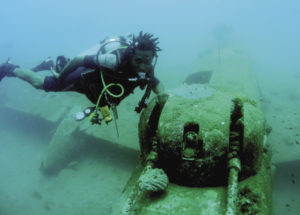 Touted as one of the best spots for diving anywhere in the south-western Pacific, Tufi’s delightful resort is located on the site of a former World War 2 McHale’s Navy style base for patrol boats. Tufi could easily be included as a cultural experience, as well, thanks to the stunning displays and performances put on by the handsome inhabitants of the satellite villages.
Touted as one of the best spots for diving anywhere in the south-western Pacific, Tufi’s delightful resort is located on the site of a former World War 2 McHale’s Navy style base for patrol boats. Tufi could easily be included as a cultural experience, as well, thanks to the stunning displays and performances put on by the handsome inhabitants of the satellite villages.
But it is the exceptional diving that invariably stays in the memory of those who visit. Right off the jetty are the wrecks of two patrol boats that were destroyed in a refuelling accident in March, 1943. A further 30 minutes by tender is the Pistoff, an amazingly intact B-25 in just 15 metres of water, and right across Collingwood Bay is the famous Black Jack B-17. In an arc, five to 10 nautical miles offshore, is an array of the most glorious reefs, many with hardly any human contact and the most amazing corals.
See www.tufidive.com.
2. Mt Wilhelm (mountaineering/trekking)
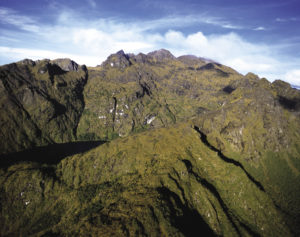 An often-underrated trek, Mt Wilhelm is a beautiful and accessible mountain. Climbing to the 4500-metre summit is a relatively easy ascent in modern mountaineering terms.
An often-underrated trek, Mt Wilhelm is a beautiful and accessible mountain. Climbing to the 4500-metre summit is a relatively easy ascent in modern mountaineering terms.
Escape Trekking Adventures general manager, Shane Goodwin, says the Keglsugl route involves climbing up and through a mountain rainforest, then along an alpine grassland glacial valley to the famous twin lakes of Piunde and Aunde. This takes between three to four hours with four stops on the way.
At Piunde (the lower lake) there are two huts, one being an old university monitoring station and the other an A-frame. Though not a technical climb, once past Lake Aunde (the uppermost lake, which feeds Piunde), there are at least four sections where sure footing is essential. In wet weather several sections can be treacherous.
The climb to the top is usually undertaken pre-dawn, starting around 1am and trekking out shortly afterwards. Preparation is the key, as weather can turn quickly, creating surprisingly cold conditions.
See www.escapetrekkingadventures.com.au.
3. Sepik River (carvings, art shopping, river travel)
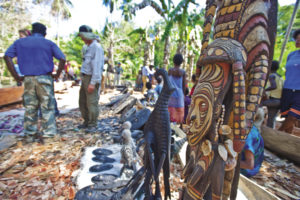 The Sepik is synonymous with the distinctive handicrafts and carvings that emanate from the many tribes and clans that dwell along its banks. Intensely symbolic and richly carved, these ornate pieces are highly prized by collectors worldwide and all but dominate the Melanesian art market. Centres like Angoram, Kaminabit and Timbunke are great for art shopping.
The Sepik is synonymous with the distinctive handicrafts and carvings that emanate from the many tribes and clans that dwell along its banks. Intensely symbolic and richly carved, these ornate pieces are highly prized by collectors worldwide and all but dominate the Melanesian art market. Centres like Angoram, Kaminabit and Timbunke are great for art shopping.
Commercial expedition adventures along the Sepik, started about 30 years ago, were driven mainly by ethnological dilettantes and enthusiasts of primitive art. Not a great deal has changed except
for the quality of watercraft now plying the wide, turbid waters.
To visit the region, you can fly in to the Middle Sepik and stay at Karawari Lodge. During the day, set out on a cruise and explore
the Kambaramba Lakes and their villages, where mystical rites and rituals persist.
See pngtours.com.
4. Rapopo (tropical bliss)
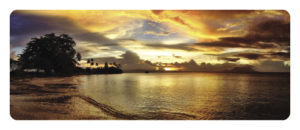 PNG is not instantly known for tropical island-style resorts, but the Rapopo Plantation Resort on the Gazelle Peninsula of New Britain can make the claim to be one of the most exotic anywhere in the country.
PNG is not instantly known for tropical island-style resorts, but the Rapopo Plantation Resort on the Gazelle Peninsula of New Britain can make the claim to be one of the most exotic anywhere in the country.
The view looks out across wide Simpson Harbour, once the rim of an ancient volcano, all the way to the devastated township of Rabaul.
Of course, there are all sorts of activities, like diving and deep-sea fishing, but Rapopo is really a place to relax and unwind. The fresh seafood of sweet reef fish, crabs and lobsters, together with succulent fruit and tropical vegetables grown in the rich black volcanic soil, make the dining experience hard to compare.
See www.rapopo.com.
5. Vanimo, Sandaun Province (surfing)
 Ask anyone about the best places to surf in PNG and the answer is almost always Kavieng. But John Borthwick, long-time surf guru, describes Vanimo, capital of Sandaun Province near the border with Indonesia, as surf that you must earn.
Ask anyone about the best places to surf in PNG and the answer is almost always Kavieng. But John Borthwick, long-time surf guru, describes Vanimo, capital of Sandaun Province near the border with Indonesia, as surf that you must earn.
“You fly from Port Moresby to Vanimo, take an old taxi eight kilometres out of town to leafy Lido village, weave amid the wooden stilt houses and shade trees, and come at last to an idyllic beach. A wide flat reef and azure lagoon extend seaward, with a right-hand wave peeling for 100 leisurely metres down the west flank, while a more robust-looking left races down the other side.”
The northern PNG swell season runs from November to April and with surfing done mostly over coral reefs, this is no place for learners. There are no surf shops either, so bring all your own gear.
See www.surfingpapuanewguinea.org.pg.
6. Mt Hagen (festival)
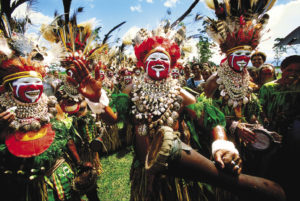 Festivals in PNG are many and varied. All across the country, every province has an excuse for a festival, but the big daddy of them all is the Mt Hagen Cultural Show, first staged in 1961, prior to PNG’s independence in 1975.
Festivals in PNG are many and varied. All across the country, every province has an excuse for a festival, but the big daddy of them all is the Mt Hagen Cultural Show, first staged in 1961, prior to PNG’s independence in 1975.
The Mt Hagen region was one of the last parts of the country to be discovered by Europeans, with the first encounters taking place in 1930 when Australian gold prospectors, the Leahy brothers, came to the Wahgi Valley.
The Australian colonial government introduced the Mt Hagen Show to promote peaceful colourful dance-offs between groups that may have once been rivals.
Held annually in August, the show is always a sell-out, so make arrangements early. Expect to see music performances and craft markets along with cultural sing-sings from the entire Western Highlands Province.
See www.pngtours.com.
7. Kiunga (birdwatching)
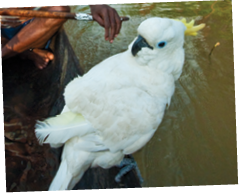 Almost all of PNG was caught up in the ferocious fighting between Allied Forces and the Japanese between 1942 and 1945.
Almost all of PNG was caught up in the ferocious fighting between Allied Forces and the Japanese between 1942 and 1945.
The New Britain capital of Rabaul was one of the first strongholds to fall and quickly became a major Japanese base, housing at its peak, in mid-1943, more than 100,000 Japanese servicemen.
Instead of capturing the base, Allied forces bypassed Rabaul, cutting off supplies and constantly bombing ship and troop movements.
At war’s end, enormous amounts of Japanese material remained and the harbour was littered with wrecks.
Today, tours of the remains are conducted and scuba divers can see what is left of the sunken wrecks.
Most notable sites are the museum at Kokopo, the Bita Paka cemetery, the Japanese War Memorial, airfield wrecks, Yamamoto’s bunker and rusting barges, still hidden in caves.
See www.papuanewguinea.travel/EastNewBritain.
8. Rabaul (Word War 2 history)
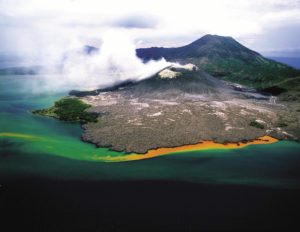 Way up the Fly River in PNG’s Western Province is the frontier town of Kiunga, known as one of the most famous locations for birdwatching in the world.
Way up the Fly River in PNG’s Western Province is the frontier town of Kiunga, known as one of the most famous locations for birdwatching in the world.
Crowned Pigeon, Yellow-eyed Starling, Large Fig-Parrot, Flame Bowerbird and the Twelve-wired Bird-of-paradise are just part of the 300-odd species of feathered specimens found there.
So famous, in fact, that Sir David Attenborough chose this location to film portions of his documentary. Local guide, Samuel Kepuknai, guided the great man himself and still leads tours from the
Kiunga Guesthouse.
See www.kiunganaturetours.com.
9. Kokoda (trekking)
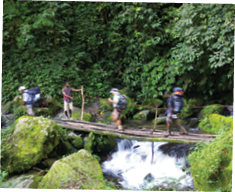 The Kokoda Track embodies so much of the spirit of PNG that it is often the only thing many people know of the entire country.
The Kokoda Track embodies so much of the spirit of PNG that it is often the only thing many people know of the entire country.
Kokoda is actually a small village along a mountain track linking the north and south coasts of PNG and was the scene of ferocious fighting in August and September 1942, between Japanese and Australian forces.
With no vehicles able to use the steep, muddy track, men had to walk, carry supplies, ammunition and wounded the entire length of the track, fighting the whole time. This event, perhaps Australia’s most significant military action of World War 2, created a heroic mythology the lives to this day.
Today, Australians see a trek to Kokoda as a rite of passage, emulating – after a fashion – the hardships and deprivations of their grandfathers.
See www.kokoda.commemoration.gov.au.
10. Bensbach Lodge (barramundi fishing)
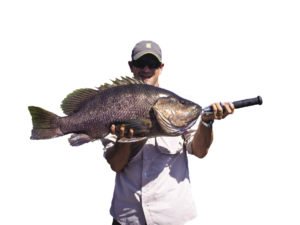 The wide, sweeping floodplains in the remote south-western corner of PNG are home to Bensbach Lodge, a sport fisherman’s paradise and renowned as one of the barramundi capitals of the world, while the rivers also teem with tarpon and saratoga.
The wide, sweeping floodplains in the remote south-western corner of PNG are home to Bensbach Lodge, a sport fisherman’s paradise and renowned as one of the barramundi capitals of the world, while the rivers also teem with tarpon and saratoga.
This is a location made for the serious angler, but equally for anyone who just wants to experience the thrill of catching one of these magnificent fighting fish.
Only accessible by charter flight, the lodge offers comfort and amenities despite its isolation and is often used by bird and wildlife enthusiasts who come for the amazing diversity of fauna.
Bensbach practices sustainable catch-and-release fishing and keeps only enough for an evening meal.
See www.pngtours.com.
First published in the March–April 2015 issue of Paradise magazine, the in-flight magazine of Air Niugini.
This article is copyright © Air Niugini 2015. No reproduction permissible without written permission of the publisher.

